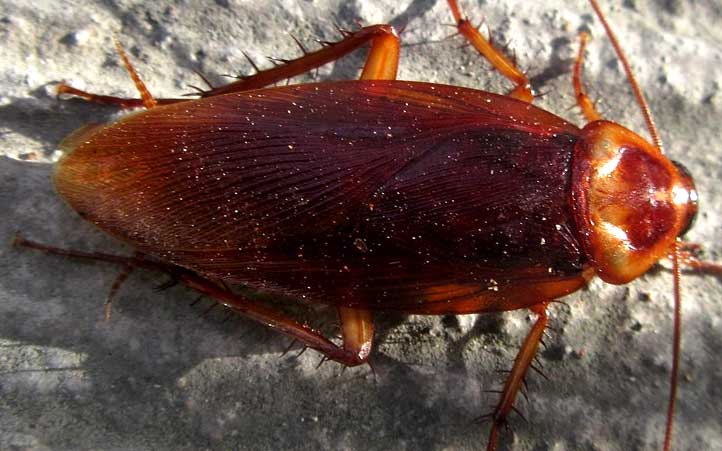Excerpts from Jim Conrad's
Naturalist Newsletter
from the March 13, 2016 Newsletter issued from Hacienda Chichen Resort beside Chichén Itzá Ruins; limestone bedrock; elevation ~39m (~128ft), N20.675°, W88.569°; central Yucatán state, MÉXICO
"AMERICAN" COCKROACH

When volunteer identifier Bea from Ontario was visiting, one day she saw a cockroach on a sidewalk leading toward the ruins. It's shown above. You can admire its streamlined shape, rich mahogany color and delicate wing venation in the close-up shown below:

Bea immediately thought the cockroach looked like the usual American Cockroach, but I asked her if she was sure, because there are other cockroach species -- such as the German and Oriental Cockroaches. Bea remembered the question, and this week she replied: Yep, American Cockroach, PERIPLANETA AMERICANA, which despite both its English name and binomial is native to Africa. It's been spread worldwide through global commerce, having reached the US as early as 1625.
American Cockroaches grow much larger than German and Oriental ones and are good fliers, while the German ones fly only rarely and Oriental ones not at all. An easy to see field mark for the American is that the ± triangular section behind the head, the "pronotum," displays a raised, pale rim that can tend toward yellowness.
We think of American Cockroaches as mainly inhabiting buildings, but in fact the species naturally lives outdoors, feeding on tiny wood particles, fungi, algae, as well as small insects, including dead or incapacitated members of their own kind.
Of course they'll also invade human habitats, but only when its requirements of food, water and heat are met, as in people's basements, bathrooms, kitchens, laundry rooms, sewers, around pet food spots, etc. This flexibility in food requirement largely accounts for the species' success.
Cockroaches themselves are fairly clean insects but they do travel over germ-rich places, and if soon afterwards they also roam about on someone's untended sandwich, they can leave germs on the sandwich, which accounts for most of the bad press they endure.
from the March 9, 2003 Newsletter issued from the woods near Natchez, Mississippi, USA
AMERICAN COCKROACH EGG CASE
I had thought that the Green Anoles who so frequently invade my trailer through the crack in the ill-fitting door were keeping my little home free of spiders and cockroaches. But this week beneath my sleeping platform I found a handsome little black item half an inch long (13 mm) shaped a bit like a woman's purse. It was the egg case of the American Cockroach. Of course I scanned it and you can see it below.
 The case was made of hard, thin, shiny, plastic-like material, and I had to marvel at the workmanship of the neat saw-toothed crown, which is visible in the scanning. Google advises that each egg case contains 16 eggs. When the eggs hatch, the young peep from the saw-toothed suture, first just one or two but latter the whole gang, then the young depart into the world leaving the case to fall apart.
The case was made of hard, thin, shiny, plastic-like material, and I had to marvel at the workmanship of the neat saw-toothed crown, which is visible in the scanning. Google advises that each egg case contains 16 eggs. When the eggs hatch, the young peep from the saw-toothed suture, first just one or two but latter the whole gang, then the young depart into the world leaving the case to fall apart.